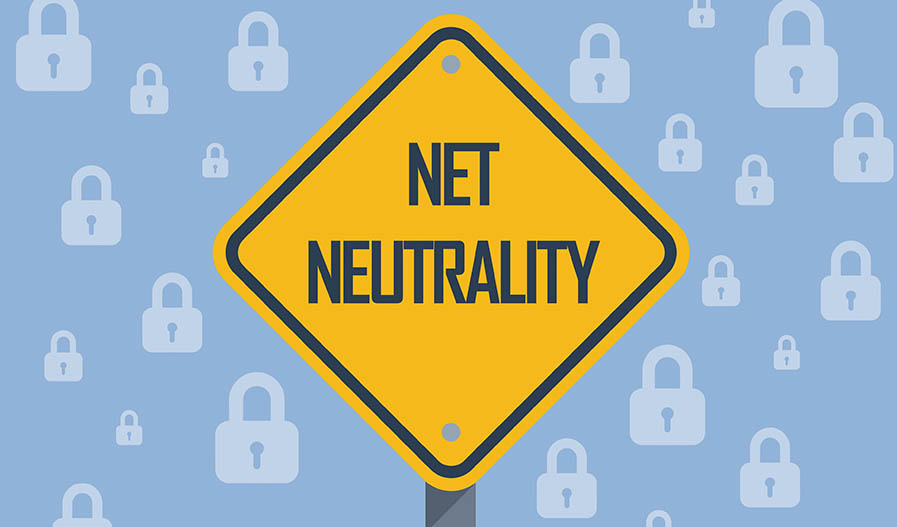
With the dawning of a new year, it’s time to set our sights on new and exciting goals. I mean, 2018 should be an exciting year for technology. Autonomous cars are just around the corner. Augmented reality is ramping up, blending the boundaries of mobile and internet technology with our everyday lives. So why does it feel like we’re stuck in the mud and not actually moving forward?
Oh, right, last month the Federal Communications Commission rolled back regulations on net neutrality, putting a new spin on “slow and steady wins the race”. Only in this race, we’re now running backwards and somehow, we still expect to win. Since the FCC just rolled back our clock, we might as well take a closer look and examine how we got here and why it matters.
Radio is a Sound Salvation
What is the FCC and how did it come to be? Well, let’s go back, way back to 1901, when Italian inventor Guglielmo Marconi and his assistant sent the first known radio transmission across the Atlantic Ocean from Poldhu, Cornwall (U.K.) to South Wellfleet, Cape Cod. This landmark moment marked the birth of wireless communication.
As with most technologies, in the beginning, radio was largely unregulated as it ventured through uncharted waters. The earliest laws centered on maritime safety (Wireless Ship Act of 1910 and Radio Act of 1912). The US government temporarily seized control and shutdown the airwaves, again, for safety reasons.
It wasn’t until the 1920s that the companies NBC and CBS emerged, thrusting radio into the fray of entertainment. Radio stations popped up all over the place, flooding the air. The need to regulate airwaves led to the Radio Act of 1927. Seven years later, the law would be revised and refined in the form of the Communications Act of 1934, which helped consolidate radio and wire communication laws and created the Federal Communications Commission (yes, the same FCC that just repealed net neutrality). The commission was created as an independent agency that would operate outside of the US government. Its initial job was to regulate licenses and to provide fair and reasonable access to the people without any discrimination.
You can read the Communications Act of 1934 here, but it’s pretty clear it was designed with its people in mind. Here’s an excerpt from its opening:
“For the purpose of regulating interstate and foreign commerce in communication by wire and radio so as to make available, so far as possible, to all the people of the United States, without discrimination on the basis of race, color, religion, national origin, or sex, a rapid, efficient, Nationwide, and worldwide wire and radio communication service with adequate facilities at reasonable charges, for the purpose of the national defense, for the purpose of promoting safety of life and property through the use of wire and radio communication…”
While radio enjoyed its golden age, another technology was waiting in the wings, about to break through: Television. It was like radio, but its content was accompanied by moving pictures. Radio entertainment megaliths CBS and NBC were among the first to dabble in television. The FCC’s umbrella was extended to this new pioneering technology. It wouldn’t be until the 1960s that television would supplant radio as the dominant medium of home entertainment.
Video Killed the Radio Star
From the 1960s to the 1990s, the FCC’s laws governing radio and television were largely unchanged. During that time, the rise of television saw a charismatic young Massachusetts Senator win a television Presidential debate against a sweaty, pale geezer, but lose that same debate on the radio (JFK vs. Nixon). We got our news from the likes of Walter Cronkite. We laughed at generational sitcoms. We explored new worlds in shows like Star Trek and Doctor Who. We rooted for Mary Tyler Moore. We marveled at live sporting events and instant replay. The world of television grew with our ever-changing culture.
And of course, we saw the rise of Music Television. (Like everything, it would take us a long time to tap its full potential. We should appreciate the abilities we have today: OK Go’s One Moment. The early music video years looked more like this: Kraftwerk’s Da Da Da). Some artists even used television as a platform to critique the corporate control over radio and television airwaves.
It wasn’t until the Telecommunications Act of 1996 that the FCC rolled out its biggest overhaul in over 60 years. The overall goal was to allow anyone to enter the communications business, and it included a provision that allowed for media cross-ownership. In spirit, the law was meant to deregulate the communications market and open up competition. But a rise in media merging would lead to fewer companies that own more media outlets. An unintended consequence is reregulation (take note here, because with the repeal of net neutrality, we may have just made a similar mistake for a second time). Aside from this, the Telecommunications Act of 1996 also marked the first inclusion of the “internet” in the FCC’s spectrum.
Lo and Behold
Like radio and television, it took decades of development before the “internet” become a household name. Believe it or not, the internet is almost 50 years old. On October 29, 1969, a UCLA grad student and his professor sent the message “Lo” (intended to be Login, but the system crashed after Lo), across a network of 2 computers from UCLA to Stanford Research Institute. This was the first message sent across the internet. After all, the internet is really just a network of computers.
In the last two decades, the internet has exploded in a way that no technology has before, and we still believe the internet is in its infancy. Among countless other things, you can stream radio channels, TV shows and movies, read and watch the news, handle all your finances, and purchase just about anything, all on desktop or mobile devices…all on the internet. Like the early years of radio, we didn’t really know where the internet would take us, and thus we really didn’t have laws to govern it.
It was in 2005 that the FCC rolled out a policy statement to help guarantee people the freedom to use the internet to access pretty much whatever they want. This was really the birth of net neutrality. It would take years of observation and analysis to figure out how to best protect internet users. The 400 paged, refined laws were ultimately rolled out in 2015. The basic gist is that it guarantees equal access to all things on the internet. An internet service provider can’t step in and alter speeds, preventing access to certain media outlets. They also can’t charge users to access certain types of content. But last month, the FCC voted to essentially undo 10 years of progress by rolling back these laws.
So What Does it Mean and How Does it Affect Me?
Earlier, we mentioned that the internet is just a network of computers. This is true. Every time you add a computer or device to the internet, you expand the global internet network. So, if someone asks you what the internet is, the short answer is, you! And as much as we’d like to believe we live in a wireless world, it all leads back to wired connections. Yes, we actually transmit internet and data signals across the world via undersea cables!
But here’s the thing: while our computers make up the internet, we still rely on internet service providers (ISPs) to maintain the connections. Remember media cross-ownership from the Telecommunications Act of 1996? Well, today, the same companies that provide us with access to the internet are the same companies that provide us with various sources of entertainment and news. If allowed under the latest regulation rollbacks, ISPs would have a clear incentive to prioritize their content over competitors’. They could hold access speeds ransom, knowing that the biggest services like Facebook or Netflix might pay up. And how would they recoup their costs? You. You would pay more for their services. Small companies that could not afford to pony up would be squashed. Instead of a freeway, it becomes a toll road, only they can charge whatever they want.
You can’t put a price on the internet, except that you can. And we may soon discover the cost.

